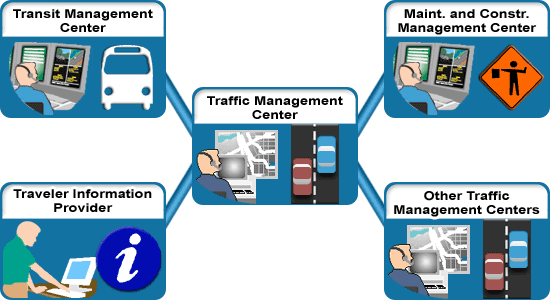Application Areas
Traffic Management
Description
This center-to-center application area covers the interface between a traffic management center and other centers and supports the following capabilities:- Exchanging near real-time traffic data and control information to support a regional traffic management strategy.
- Providing information to maintenance and construction operations for the efficient management of maintenance activities.
- Providing near real time traffic information for use by traveler information providers (organizations that provide traveler information directly to the traveling public) and other centers such as emergency management, transit management, maintenance and construction management, and the media. Traffic and incident information collected by the media is collected by the traffic management center.
- Developing a view of potential incidents by acquiring event information from other centers.

National ITS Architecture Interface
This application area focuses on the distribution of road network information by the Traffic Management Subsystem (TMS) to other centers. The TMS disseminates current and forecasted traffic information to EM, ISP, MCMS, TRMS, and the Media, as well as to Traffic Management Subsystems in neighboring jurisdictions to ensure efficient and effective management of various traffic situations. Coordinating information is exchanged between Traffic Management Subsystems to allow remote control of another center's field devices. The TMS also gathers information from the Media and Event Promoters via center-to-center interfaces. Finally, this application area includes an interface to report HOV lane violations.Applicable Standards
In general, the following standards are applicable to Traffic Management deployments. To determine which specific standards are applicable for a deployment you will need to determine which architecture flows will be needed for the Traffic Management piece of your deployment. Contact your local FHWA ITS Division Specialist or an ITS Standards Program Field Support Team contact
Deployment Resources
Deployment resources can be found in the deployment resources
section.
- TMDD Guide
- NTCIP Case study reports (1999-2004)
- NTCIP 9010 — XML in ITS Center-to-Center Communications